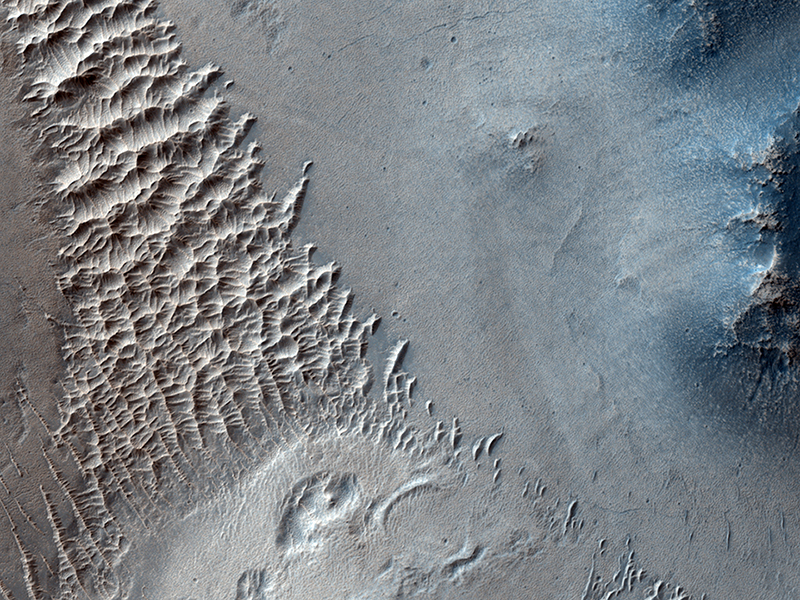Spacecraft on Mars have captured images of barren, desertlike landscapes complete with dunes of sand. But the windswept features are not identical to their terrestrial counterparts. The surface of the Red Planet is dotted by midsized sand masses not found on Earth. These features go by a variety of names: megaripples, sand ripples, sand ridges, and the less melodic transverse aeolian ridges (TARs) chief among them. But the nomenclature is inconsistent, causing confusion that hampers scientific advancement. Now, new research has proposed an official naming scheme for wind-formed features.
“Because we’re seeing new things on Mars, people have adapted what they are calling things,” said Mackenzie Day, a researcher at the University of California, Los Angeles. Day and James Zimbelman of the Smithsonian Institution coauthored the new paper, published in the journal Icarus. “People have adapted in slightly different ways.”
Broadly based, the new system classifies aeolian, or wind-created, features by size and geomorphology.
“As we’re getting new information, having a standard nomenclature makes sure everybody is on the same page,” Day said. “If we’re all talking about the same thing in the same way, it makes it easier as a scientific community to move forward in understanding what’s going on.”
Blowing in the Wind
Aeolian bed forms are piles of moving sand brushed across the planet’s surface by the wind. On Earth, the largest of these features are sand dunes, which can stretch for tens to hundreds of meters in length. Small ripples only a few tens of centimeters long can be carved on top of these dunes.
“Bed forms are really amazing interactions between the atmosphere and the surface,” said Serina Diniega, a research scientist at NASA’s Jet Propulsion Laboratory who is not associated with the new paper. “If you see one, you immediately have a whole bunch of information about the environment.”
In addition to dunes and ripples, Mars has a third type of bed form: transverse aeolian ridges. TARs appear to have been created by the wind but move on much slower timescales than their fellow bed forms and seem to be coated with a layer of fine-grained dust.
Day and Zimbelman proposed a broad frame of terminology for ripples, TARs, and dunes that relies first on the size and geomorphology of the features. As surface observations (anticipated soon from Curiosity and Perseverance) allow scientists to classify grain size and dust cover, the terminology can be further constrained.
Small ripples, for instance, are measured on centimeter scales in height and are classified as straight crested. Megaripples are measured at less than a meter in height and may be straight crested or sinuous. Unlike small ripples, megaripples may include coarse grains. TARs are classified as larger than a meter in height and straight crested. Dunes, the largest aeolian bed form on Mars, are classified as taller than 3 meters and have wildly varying geomorphologies: from straight crested or sinuous to radially symmetrical stars.

According to Ryan Ewing, a geologist at Texas A&M University not involved in the new study, the biggest challenge of a settled nomenclature will be agreeing on the processes that created TARs. “I think as we uncover more about how sediments move on Mars by wind, that will help the community refine their definitions of these [features],” he said.
“I really like this paper because it’s attempting to apply some sort of structure around these terms,” said Diniega. “Using a classification based on looking at both Earth and Mars is better than a classification system based only on Earth.”
Sand Through the Solar System
Bed forms aren’t limited to Earth and Mars. They’ve been spotted on Venus and on Saturn’s moon Titan, and there have been signs of them on Pluto and Comet 67/P.
“Every place that has an atmosphere—and even places that don’t have an atmosphere—we see an example of these bed forms,” Diniega said.
The new classification system should work on these bodies as well as on Earth and Mars, researchers said.
“As we start exploring the solar system more, like sending Dragonfly to Titan, it would be nice to have a nomenclature that could be applied independent of what planet you’re on,” Day said.
—Nola Taylor Tillman (@NolaTRedd), Science Writer






